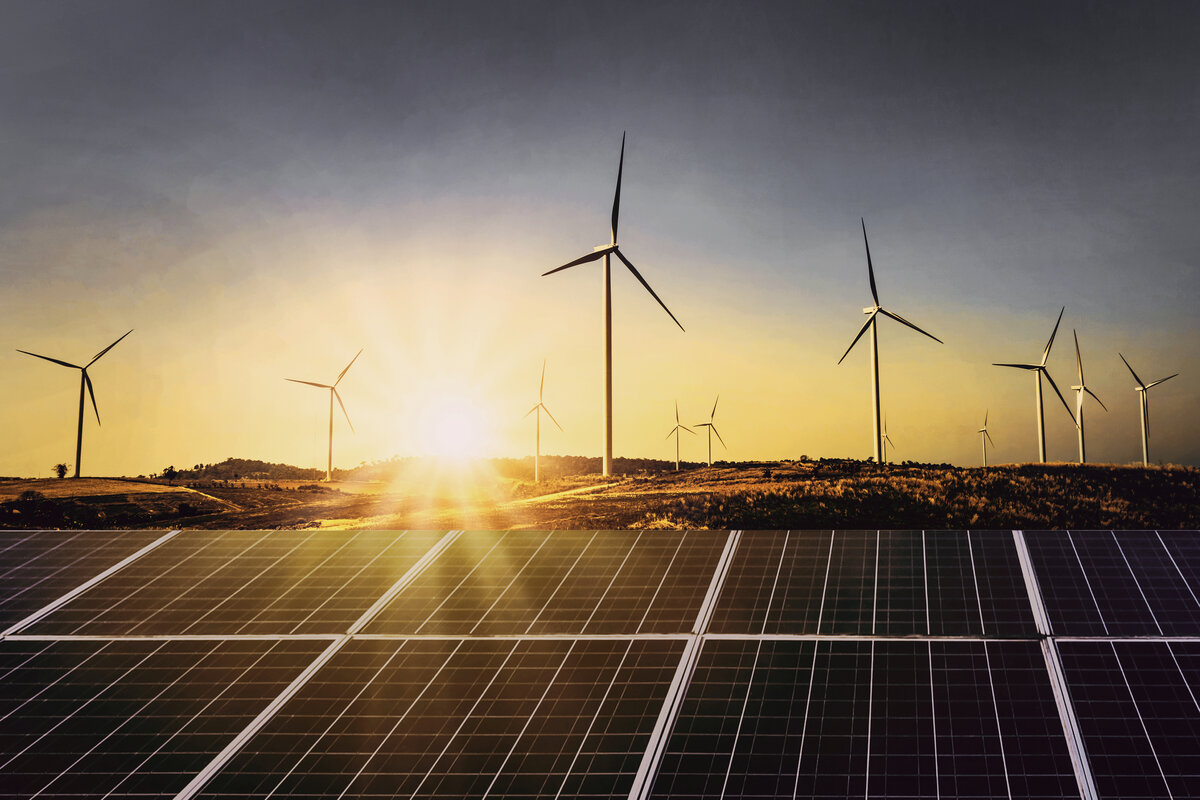
UPDATE: On his first day in office, President Joe Biden signed an executive order to start the process for the United States to re-enter the Paris Agreement to limit global warming. On Feb. 19, 2021, the U.S. officially rejoined the global pact.
More electric cars, and fewer gas guzzlers. President-elect Joe Biden’s climate plan would fundamentally change how we live, work and play.
All the states and the District of Columbia will be impacted by the plan — for better or worse.
At the heart of the Biden climate plan are two key goals:
- Net-zero carbon emissions: Biden wants carbon-free electricity production by 2035 and net-zero carbon emissions by 2050. The BBC called this target “the most progressive climate strategy the U.S. has ever attempted.”
- Millions of new jobs: Biden’s climate policies aren’t just about saving the planet — they’re also a strategy to create millions of new jobs and transform the economy.
These climate goals might seem ambitious, but with John Kerry leading an experienced team of climate-conscious diplomats and an incoming Democratic-controlled Senate, Biden’s vision for a healthier planet is closer to becoming a reality.
Which states will be winners under Biden’s climate change plan? Which will be losers?
LawnStarter combed through the data to rank the states that will be most heavily impacted by Biden’s climate policies. We looked at 30 key factors connected to his plan, from the frequency of natural disasters to oil production to the share of electricity from renewable resources. See which states stand to change the most in our rankings below.
Table of Contents
State Rankings
See how each state fared in our ranking:
| OVERALL RANK | State | Overall Score | Climate Change Impact Rank | Infrastructure Rank | Pollutants Rank | Clean Energy Potential Rank | Environmental Policies Rank | Waste Management Rank |
|---|---|---|---|---|---|---|---|---|
| 1 | Texas | 62.43 | 1 | 22 | 2 | 1 | 23 | 9 |
| 2 | Louisiana | 58.62 | 14 | 9 | 8 | 15 | 5 | 14 |
| 3 | Oklahoma | 56.59 | 9 | 4 | 32 | 19 | 7 | 25 |
| 4 | West Virginia | 55.51 | 35 | 1 | 20 | 30 | 8 | 20 |
| 5 | Missouri | 54.43 | 7 | 15 | 21 | 9 | 10 | 11 |
| 6 | Tennessee | 54.42 | 4 | 46 | 14 | 26 | 3 | 26 |
| 7 | Mississippi | 54.02 | 10 | 3 | 26 | 8 | 18 | 29 |
| 8 | Kansas | 53.78 | 11 | 32 | 35 | 18 | 1 | 39 |
| 9 | Alabama | 53.38 | 3 | 37 | 25 | 16 | 5 | 41 |
| 10 | Ohio | 51.82 | 15 | 30 | 4 | 31 | 22 | 10 |
| 11 | Alaska | 51.22 | 49 | 11 | 17 | 45 | 2 | 12 |
| 12 | Wyoming | 50.67 | 29 | 19 | 50 | 5 | 8 | 13 |
| 13 | Georgia | 49.79 | 6 | 43 | 19 | 14 | 14 | 35 |
| 14 | Indiana | 49.27 | 18 | 28 | 3 | 23 | 26 | 38 |
| 15 | Nebraska | 49.21 | 24 | 33 | 48 | 12 | 4 | 46 |
| 16 | Nevada | 48.62 | 39 | 51 | 11 | 4 | 12 | 3 |
| 17 | Arkansas | 47.96 | 19 | 12 | 36 | 11 | 20 | 42 |
| 18 | Kentucky | 47.95 | 23 | 29 | 33 | 20 | 17 | 19 |
| 19 | Arizona | 47.55 | 39 | 42 | 18 | 2 | 19 | 31 |
| 20 | Illinois | 47.24 | 8 | 20 | 5 | 25 | 32 | 15 |
| 21 | New Mexico | 46.86 | 37 | 13 | 42 | 3 | 25 | 22 |
| 22 | Utah | 46.82 | 43 | 48 | 7 | 6 | 15 | 32 |
| 23 | Pennsylvania | 45.83 | 12 | 7 | 1 | 21 | 45 | 17 |
| 24 | Florida | 44.56 | 25 | 50 | 9 | 10 | 24 | 8 |
| 25 | Idaho | 44.39 | 34 | 24 | 30 | 46 | 13 | 28 |
| 26 | Montana | 44.28 | 33 | 25 | 37 | 36 | 20 | 18 |
| 27 | Michigan | 44.24 | 27 | 8 | 6 | 35 | 33 | 30 |
| 28 | South Carolina | 43.19 | 13 | 35 | 23 | 13 | 27 | 37 |
| 29 | South Dakota | 42.29 | 41 | 10 | 51 | 44 | 15 | 49 |
| 30 | Virginia | 42.05 | 5 | 41 | 29 | 17 | 31 | 27 |
| 31 | North Carolina | 41.58 | 2 | 44 | 12 | 22 | 35 | 36 |
| 32 | North Dakota | 40.93 | 46 | 36 | 47 | 40 | 10 | 51 |
| 33 | Colorado | 40.59 | 21 | 38 | 24 | 7 | 30 | 40 |
| 34 | New Hampshire | 40.08 | 45 | 26 | 46 | 41 | 29 | 2 |
| 35 | New York | 38.37 | 17 | 6 | 15 | 42 | 46 | 5 |
| 36 | New Jersey | 37.22 | 22 | 18 | 13 | 28 | 43 | 24 |
| 37 | Hawaii | 37.21 | 50 | 21 | 43 | 43 | 27 | 21 |
| 38 | Rhode Island | 36.45 | 36 | 2 | 44 | 29 | 47 | 4 |
| 39 | Iowa | 36.35 | 20 | 16 | 34 | 39 | 38 | 50 |
| 40 | Maryland | 36.09 | 16 | 47 | 38 | 33 | 37 | 7 |
| 41 | Wisconsin | 35.74 | 31 | 27 | 16 | 27 | 39 | 47 |
| 42 | Massachusetts | 35.30 | 30 | 17 | 40 | 38 | 40 | 16 |
| 43 | Delaware | 35.05 | 32 | 49 | 10 | 24 | 36 | 33 |
| 44 | District of Columbia | 31.80 | 50 | 31 | 45 | 50 | 34 | 1 |
| 45 | Maine | 30.92 | 48 | 5 | 39 | 48 | 41 | 43 |
| 46 | California | 30.10 | 26 | 14 | 22 | 32 | 49 | 23 |
| 47 | Minnesota | 29.43 | 42 | 45 | 41 | 37 | 42 | 45 |
| 48 | Washington | 27.10 | 44 | 40 | 28 | 49 | 44 | 6 |
| 49 | Connecticut | 26.57 | 28 | 23 | 27 | 34 | 50 | 34 |
| 50 | Oregon | 25.28 | 38 | 39 | 31 | 47 | 48 | 44 |
| 51 | Vermont | 14.09 | 47 | 34 | 49 | 51 | 51 | 48 |

Winners and Losers
Southern heat
Six of the top 10 ranked states are in the South, and it’s easy to see why. States like Louisiana and Mississippi tend to have fewer existing environmental policies and less reliable infrastructure while also remaining susceptible to climate-related disasters such as hurricanes and floods.
All this has the potential to change under Biden’s climate plan. The coming years could be an exciting time to move south — and Americans have taken notice.
Appalachia rising
States along the Appalachian Mountains such as Tennessee and West Virginia find themselves at the top of our ranking.
These states have traditionally been where the U.S. has mined for coal, leading to higher rates of pollutants and lower current rates of electricity from renewable sources.
Biden’s climate policies could bring some much needed change and investment to a region that has been economically struggling for decades.
A Texas-size impact
The Lone Star State took the top spot in the Climate Change Impact category with over 63 billion-dollar natural disasters in the past 10 years.
While Texas has borne the brunt of climate-related damages, it also is poised to reap some benefits from its enormous clean energy potential, especially from wind power. They’re not called the Great Plains for nothing.
Pacific coasting
California, Oregon and Washington are at the bottom of our ranking, mostly because these states have already implemented a number of environmentally friendly measures and infrastructure projects.
Washington, for example, already gets 77% of its electricity from renewable sources. While the West Coast is a lovely place to live, it’s not likely to see great changes emerging from Biden’s climate policies.
Ask The Experts
Biden’s climate plan touches nearly every aspect of American society, from energy to health to jobs. With so many competing factors, it’s difficult to see what lies ahead.
That’s why LawnStarter asked a panel of experts to read the tea leaves about the impact of Joe Biden’s climate policies and how they might alter our country’s future for decades to come.
Explore below how the experts answered these questions:
- Is Joe Biden’s climate plan enough to curb the most damaging effects of climate change? Why or why not?
- What is the biggest misconception about Joe Biden’s climate plan?
- With the Democrats now in control of the U.S. Senate, what would it take for the Biden administration to realize its climate plan? How soon could that happen?
- Fossil-fuel lobbyists argue that Joe Biden’s climate policy would “eliminate jobs and shift energy production overseas.” If this is true, how could the Biden administration best support states that depend heavily on oil, natural-gas and coal production to sustain their economies in the transition to renewable energy?








Is Joe Biden’s climate plan enough to curb the most damaging effects of climate change? Why or why not?
The plan is short on details, but from what I gather, it’s not even close to sufficient for climate change mitigation.
The plan is not bad in that there are some decent, common-sense proposals for clean energy, auto-emissions, and infrastructure upgrades. It also appears to recognize the need for investment in climate adaptation, especially for marginalized communities.
However, If the goal is to make a meaningful impact on greenhouse gas emissions, which is the only way to slow rising temperatures, then anything short of a heavy tax on carbon and other greenhouse gasses is not going to be enough.
I find no support for this idea in the plan.
What is the biggest misconception about Joe Biden’s climate plan?
I can’t answer this without looking at some public opinion data, but if I had to guess, the biggest misconception among the general public might be that the plan would be sufficient to mitigate climate change. It is not.
With the Democrats now in control of the U.S. Senate, what would it take for the Biden administration to realize its climate plan? How soon could that happen?
The odds of moving forward with Biden’s climate plan certainly increased with the capture of the two Georgia Senate seats, but it’s important to remember that time is short, margins are razor thin, and Biden will have a full plate when he’s inaugurated. GIven the multi-dimensional nature of the plan, it’s likely that he will attempt to tackle it piecemeal, rather than in a single giant bill. If so, the plan’s less-controversial components, especially those that create jobs, such as infrastructure investment, are likely to move forward with less resistance. I also expect Biden to act on the components of his plan that do not require much (or any) Congressional support, such as revising auto-emission standards, encouraging clean manufacturing, or investing in research. I am less confident that he will be able to gain much ground on the more ambitious parts, such as his promise to transform energy sectors and shift reliance away from fossil fuels, especially given that a number of Democratic senators hail from oil-producing states.
Fossil-fuel lobbyists argue that Joe Biden’s climate policy would “eliminate jobs and shift energy production overseas.” If this is true, how could the Biden administration best support states that depend heavily on oil, natural gas and coal production to sustain their economies in the transition to renewable energy?
This is a difficult issue, as any societal transition from old to new technology will necessarily have winners and losers.
For both economic and political reasons, it makes sense for the government to invest in job training to help fossil fuel industry workers transition to new jobs in new industries.
I think the argument about shifting jobs overseas is a red herring, in part because it assumes that the global supply and demand for fossil fuels will remain the same if the U.S. invests heavily in clean energy and shifts its energy production away from fossil fuels.
What is more likely is that U.S. investment in clean energy would lower the price of wind, solar, and nuclear technology, which would help facilitate their spread to other parts of the world.
Moreover, as the world’s second-largest energy consumer (behind China), a U.S. shift away from fossil fuels would be likely to depress their prices through reduced demand. The result would be more of a net loss for fossil fuel jobs than a shifting of jobs overseas.

Is Joe Biden’s climate plan enough to curb the most damaging effects of climate change? Why or why not?
His plan will help to deal with the most dangerous aspects of climate change, but it will take time for these efforts to have an impact in conjunction with efforts in other countries.
The process cannot be reversed overnight, but it is possible to begin to move along the appropriate route by limiting out “carbon footprint” which will include energy conservation.
What is the biggest misconception about Joe Biden’s climate plan?
Probably the biggest misconception is that it will hurt American manufacturers who will be at a competitive disadvantage.
Some companies could face a disadvantage while others would have a competitive advantage. The overall impact would be neutral, contrary to the misperception.
Some industries, however, would have to make adjustments and focus more on conservation and improved energy usage.
With the Democrats now in control of the U.S. Senate, what would it take for the Biden administration to realize its climate plan? How soon could that happen?
I do not anticipate major changes. It will take bipartisan support in the Senate since the filibuster requires 60 votes to pass legislation and there may be a large number of Republicans and even a few Democrats who disagree with the specifics of a bill dealing with climate change. There are parliamentary techniques that can be used to avoid the 60 votes required as managed by the Republicans the last four years in dealing with the reconciliation of Senate and House versions. (This was the method used by the Republicans to try to undo the end of Obamacare by a simple majority vote until Senator McCain cast the deciding vote against). The easiest part will be undoing the actions taken by executive order under the Trump Administration. I think that climate change efforts will progress slowly but will have a better chance of being adopted with Democratic control of the Senate. The one key political fact is that while it could be possible to push through some legislation, the new administration will have to choose which programs are the most important (as the Republicans did with the attempt to repeal Obamacare) and for which it will make such an effort to push through. Even victories have costs, and not all programs will have a high enough priority. Right now dealing with the Covid pandemic and restarting the economy and dealing with the costs of Covid will take precedence.
Fossil-fuel lobbyists argue that Joe Biden’s climate policy would “eliminate jobs and shift energy production overseas.” If this is true, how could the Biden administration best support states that depend heavily on oil, natural-gas and coal production to sustain their economies in the transition to renewable energy?
There might indeed be some job losses in some sectors that would be replaced by jobs in other areas (coal mining jobs lost while jobs in the solar industry would be gained).
It is highly unlikely that there would be jobs shipped overseas in the aggregate. This claim by opponents is misleading and is designed to scare voters.
What does happen, however, is that persons unemployed in coal mining may not be able to get similar jobs in the solar energy industry.
Winners and losers could even out, but will not necessarily be the same people.

Is Joe Biden’s climate plan enough to curb the most damaging effects of climate change? Why or why not?
Biden will have his hands full initially on trying to recapture lost ground battling climate change during the Trump years. Those years are essentially ones where we got knocked back and off course with respect to combating climate change.
Biden will surely move us in the right direction, but the lost four years will mean that catching up rather than significantly curbing damaging effects will be the first order of business.
What is the biggest misconception about Joe Biden’s climate plan?
During the campaign the Republicans portrayed Biden as a radical climate activist willing to sacrifice jobs in the name of combating climate change. He was characterized as fully embracing the Green New Deal, for example.
His commitment to a safer, healthier environment is clear and genuine, but any actions must not harm fundamentally economic interests.
Instead, as he argues, his plan is sensitive and even sold as a bold economic and employment plan as opposed to a strictly environmental policy.
Fossil-fuel lobbyists argue that Joe Biden’s climate policy would “eliminate jobs and shift energy production overseas.” If this is true, how could the Biden administration best support states that depend heavily on oil, natural-gas and coal production to sustain their economies in the transition to renewable energy?
First of all, fossil fuel lobbyists are supposed to throw cold water on any initiatives aimed at limiting their production.
Second of all, when the data is evident that moving on a green agenda can at least in some major ways produce positive economic and health benefits even some Republicans will more to the Biden position.

Is Joe Biden’s climate plan enough to curb the most damaging effects of climate change? Why or why not?
I do not know if we can “curb the most damaging effects of climate change” without some radical global intervention at this point, so a national plan developed to pass through a divided government does not seem likely to get us there, but it is a move that can help.
The global position is largely symbolic — the Paris Agreement, while broad-based — committed signatories to no action other than publishing a plan.
That at least gets it on the agenda, and if the U.S. takes a signal position on climate change, it could induce others to join if the U.S. still has some soft power.
What is the biggest misconception about Joe Biden’s climate plan?
One big misconception is that it is a radical, anti-energy plan. This is not true.
The goal is to become carbon-pollution free within 15 years — this is not the same as carbon free, which some have advocated.
Instead it would blend energy production with pollution controls and carbon sequestration while trying to encourage investment in non-carbon energy production.
This is likely to occur anyway because of costs and industry awareness that has many carbon-based energy companies investing heavily in non-carbon production.
Fossil-fuel lobbyists argue that Joe Biden’s climate policy would “eliminate jobs and shift energy production overseas.” If this is true, how could the Biden administration best support states that depend heavily on oil, natural-gas and coal production to sustain their economies in the transition to renewable energy?
The centerpiece of the Biden plan is an environmentally friendly infrastructure and stimulus package.
This would be a very important step, as it could help reconstruct energy and transportation grids to being more environmentally friendly, setting a longer term agenda that would provide the backbone to non-carbon energy reliant and transportation grids by installing charging stations, subsidizing solar, wind, hydro and biomass energy, developing more efficient and accessible mass transport systems, etc.
There has been some bipartisan support for both infrastructure and stimulus bills, neither of which was achieved by the last administration.
Unless some factions are dedicated to denying a Biden administration any successes, this could be possible, particularly with the president-elect’s history of cooperation across the legislative aisle.
Such a plan could be the job creating engine for these areas where carbon-dependent jobs are concentrated and which face an inevitable decline.

Is Joe Biden’s climate plan enough to curb the most damaging effects of climate change? Why or why not?
It is unlikely to be enough by itself. Tackling climate change, as a global issue, is going to take a worldwide effort well beyond what even large economies like the U.S. can do alone.
There are some aspects to Biden’s plan that are explicitly global, including recommitting the U.S. to the Paris Agreement.
However, the challenge will be to convert any domestic changes the U.S. makes in political capital used to convince other countries to likewise reduce their emissions, especially China.
What is the biggest misconception about Joe Biden’s climate plan?
I’d say the biggest misconception is that combating climate change is necessarily at odds with economic growth.
When discussing climate policy, it is frequently described as being a choice between growth and climate.
One thing Biden’s plan tries to do is merge these two goals, speaking much about building infrastructure and creating new jobs in the automobile and construction industries.
With the Democrats now in control of the U.S. Senate, what would it take for the Biden administration to realize its climate plan? How soon could that happen?
Biden will quickly rejoin the Paris Agreement, sign a series of executive orders, and direct federal agencies to begin the rulemaking processes to interpret existing laws in ways that will enable them to develop policies that address climate change. With narrow control over the Senate, Democrats will propose climate legislation, but it is by no means guaranteed to pass. Unless significant rules changes occur–like abolition of the filibuster, which is an increasing possibility–Democrats will need considerable support from both moderate Republicans like Susan Collins and conservative-leaning Democrats like Joe Manchin. It is unlikely to be easy–or pretty.
Fossil-fuel lobbyists argue that Joe Biden’s climate policy would “eliminate jobs and shift energy production overseas.” If this is true, how could the Biden administration best support states that depend heavily on oil, natural-gas and coal production to sustain their economies in the transition to renewable energy?
There may be ways to shift resources to states that see large job losses, particularly through additional unemployment support, job training, and using federal dollars to support individuals with skills in polluting industries to use those skills in more environmentally-friendly ways (again, looking at infrastructure development).
Of course, the challenge will be convincing individuals and states that they will ultimately benefit from implementation of a Biden climate plan even if it means that their current jobs will become obsolete.
That will not be an easy task, and is already one reason why oil- and coal-heavy states like West Virginia have turned sharply against Democratic administrations in recent years.

Is Joe Biden’s climate plan enough to curb the most damaging effects of climate change? Why or why not?
No. No single plan is up to the task, and certainly none of the plans out there now respond nearly aggressively enough.
With each day that ticks by, the need for us to act grows greater. But Biden’s plan is the best we’ve seen in the White House up until now, and it has the potential to place us back into a leadership role — or at least a respectable role — in this area.
What is the biggest misconception about Joe Biden’s climate plan?
That it kills jobs. Biden’s plan is a jobs plan. He wants to create hundreds of thousands of new jobs in research, manufacturing, and construction.
In fact, I think that, if carried out, Biden’s plan would be more effective as an economic stimulus than as a climate mitigation effort.
With the Democrats now in control of the U.S. Senate, what would it take for the Biden administration to realize its climate plan? How soon could that happen?
Biden will quickly rejoin the Paris Agreement, sign a series of executive orders, and direct federal agencies to begin the rulemaking processes to interpret existing laws in ways that will enable them to develop policies that address climate change. With narrow control over the Senate, Democrats will propose climate legislation, but it is by no means guaranteed to pass. Unless significant rules changes occur–like abolition of the filibuster, which is an increasing possibility–Democrats will need considerable support from both moderate Republicans like Susan Collins and conservative-leaning Democrats like Joe Manchin. It is unlikely to be easy–or pretty.
With the Democrats now in control of the U.S. Senate, what would it take for the Biden administration to realize its climate plan? How soon could that happen?
Biden will quickly rejoin the Paris Agreement, sign a series of executive orders, and direct federal agencies to begin the rulemaking processes to interpret existing laws in ways that will enable them to develop policies that address climate change. With narrow control over the Senate, Democrats will propose climate legislation, but it is by no means guaranteed to pass. Unless significant rules changes occur–like abolition of the filibuster, which is an increasing possibility–Democrats will need considerable support from both moderate Republicans like Susan Collins and conservative-leaning Democrats like Joe Manchin. It is unlikely to be easy–or pretty.
Fossil-fuel lobbyists argue that Joe Biden’s climate policy would “eliminate jobs and shift energy production overseas.” If this is true, how could the Biden administration best support states that depend heavily on oil, natural-gas and coal production to sustain their economies in the transition to renewable energy?
I don’t believe this is true for the economy as a whole or in the long run. These are scare tactics.
It is, however, true that areas economically dependent on fossil fuels will experience short-term pain without a good transition plan.
One of the best things Biden can do, I think, is to invest in these places as centers of green innovation and manufacturing, thus enabling them to modernize their economies through stable, high-paying green jobs.
Much of this is in Biden’s plan; it also happens to be the basis for the Green New Deal.

Is Joe Biden’s climate plan enough to curb the most damaging effects of climate change? Why or why not?
Due to the urgency of climate change and expensive repercussions from fires, hurricanes, flooding, drought and other disasters, transition away from fossil fuels like coal, oil, gas and LNG must occur immediately.
All subsidies to fossil fuels and all bailouts to fossil fuel companies must end right away under the Biden administration.
COVID-related relief distributed to energy companies was used irresponsibly in corporate buybacks, bailouts, and large executive bonuses, while workers were laid off.
Global banks are avoiding coal — it is a liability. Similarly European investors recently decided U.S. fracked gas was too dirty.
Oil and gas impacted communities in the U.S. are asking local and state governments to ban fracking, to stop building pipelines, to avoid risky transport by road and rail, and to halt export terminals.
Fracked gas is not viable due to the costs associated with water and air pollution, particularly leaked methane, a potent greenhouse gas, and toxic pollutants spread throughout the gas lifecycle, including from radioactive waste.
Moving forward, one of the most effective investments the Biden administration could make to benefit the whole economy would be to support clean, distributed (localized), sustainable energy.
Renewable energy needs to be the cornerstone of an equity-centered Green New Deal.
Wind and solar are cost competitive with other energy sources. Renewables create more jobs than fossil fuels and well-paid green energy jobs have fewer occupational risks, thus contributing to a more resilient economy by supporting a healthier workforce with job security, rather than the boom-and-bust economies and health risks (asthma and respiratory disease, cancer, etc.) associated with fossil fuels.
Methodology
To determine the impact that Joe Biden’s climate plan will have on each of the 50 U.S. states and the District of Columbia, LawnStarter first reviewed the issues and priorities outlined in the president-elect’s climate agenda.
We then identified and collected the most recently available data for 30 key metrics related to those climate issues and priorities, grouping these into six categories:
- Climate Change Impact
- Infrastructure
- Pollutants
- Clean Energy Potential
- Environmental Policies
- Waste Management
Next, we assigned a weight to each metric based on its significance within its indicator category and applied a weight-based score out of 100 points. Each single weight is equal to roughly 1.85 points, calculated by dividing a total possible score of 100 points by the total number of weights, 54.
Finally, we compared the 50 U.S. states and the District of Columbia by summing up their scores across the 30 indicators. The state that scored the highest was ranked No. 1, or “most impacted,” while the state with the lowest score was ranked No. 51, or “least impacted.”
| Metric | Weighting | Min Value | Max Value |
|---|---|---|---|
| Number of Billion-Dollar Natural Disasters in Past Decade | 5.55 | 0 | 63 |
| Total Economic Impact of Large Natural Disasters in Past Decade | 3.70 | 7906.1 | 415552.7 |
| Climate Change Impact Category Total | 9.26 | ||
| Road Condition (% of Major Roads in Poor or Mediocre Condition) | 3.70 | 15 | 79 |
| Bridge Condition (% of Bridges in Poor/Structurally Deficient Condition) | 3.70 | 1 | 22 |
| Number of Electric Vehicle Charging Stations | 1.85 | 45 | 28327 |
| Broadband Coverage | 3.70 | 0.543 | 0.983 |
| Power Grid Reliability (Average outage duration per customer, per year; minutes) | 3.70 | 59.43 | 630.29 |
| Share of Workforce in Auto Industry | 1.85 | 0.019 | 0.07 |
| Oil Production | 3.70 | 4 | 1850714 |
| Median Age of Home | 3.70 | 26 | 63 |
| Share of population that uses public transport, bicycles or walks to commute; 2019 | 3.70 | 0.014 | 0.51 |
| Infrastructure Category Total | 29.63 | ||
| Water Quality (no. of violations) | 3.70 | 10 | 3433 |
| Air Quality - Federally Reportable Violations | 3.70 | 1 | 347 |
| Toxic Chemicals Release (per sq. mile) | 3.70 | 39.48 | 3590.56 |
| Risk-Screening Environmental Indicator Score | 1.85 | 316.94 | 353924162.76 |
| Pollutants Category Total | 12.96 | ||
| Share of Electricity from Renewable Sources | 5.55 | 0.018 | 0.997 |
| Potential for Solar Power | 3.70 | 0.67 | 1.19 |
| Potential for Wind Power | 3.70 | 192.36 | 1347992.1 |
| Clean Energy Potential Category Total | 12.96 | ||
| Climate Action Plan | 5.55 | 0 | 2 |
| Plastic Bag Bans | 1.85 | 0 | 2 |
| Beverage Container Deposit Laws | 1.85 | 0 | 1 |
| Yard Debris Bans | 1.85 | 0 | 2 |
| Food Waste Disposal Bans | 1.85 | 0 | 1 |
| Electronic Waste Recycling Programs | 1.85 | 0 | 1 |
| Multifamily Recycling Policies | 3.70 | 0 | 2 |
| Share of Households with Residential Food Collection Programs | 1.85 | 0 | 0.90 |
| Mandatory Recycling Laws | 3.70 | 0 | 1 |
| Tailpipe Emission Standards | 3.70 | 0 | 1 |
| Environmental Policies Category Total | 27.78 | ||
| Number of Recycling Facilities per 100,000 residents | 3.70 | 0 | 0.32 |
| Number of Large Waste Facilities per 100,000 residents | 3.70 | 0 | 1.58 |
| Waste Management Category Total | 7.41 |
Limitations
Data for LEED-certified residential and commercial spaces was originally intended to be included in our data set to demonstrate which states are most or least likely to benefit from Biden’s climate plan to “upgrade 4 million buildings and weatherize 2 million homes over 4 years” and “spur the construction of 1.5 million sustainable homes and housing units.”
However, consistent data could not be obtained from the source, the U.S. Green Building Council, at the time of collection.
Sources: Alliance of Automobile Manufacturers, Alternative Fuels Data Center (U.S. Department of Energy), American Council for an Energy-Efficient Economy, BroadbandNow, Bureau of Transportation Statistics, Center for Climate and Energy Solutions, Environmental Finance Center (University of North Carolina-Chapel Hill), Facility Level Information on GreenHouse gases Tool (U.S. Environmental Protection Agency), House Method, National Centers for Environmental Information (National Oceanic and Atmospheric Administration), National Conference of State Legislatures, Nebraska Department of Environment and Energy, Northeast Recycling Council, The Recycling Partnership, TRIP, U.S. Composting Council, U.S. Energy Information Administration and U.S. Environmental Protection Agency
Why This Study Matters
While Biden’s climate change plan could face pushback and opposition, there’s no denying that his administration will fundamentally alter America’s approach to climate change.
But not all states are primed to benefit from Biden’s changes equally. The states themselves, especially those with large employment in the energy sector, have vastly different climate agendas.
At the same time, increasingly intense wildfires and hurricanes make clear that the negative effects of climate change are uneven across the U.S.
Climate change, of course, isn’t only a U.S. issue. Biden’s plan aims to make America a model, a key player in how the world tackles the problem. To that end, on Day 1, Biden plans to return the U.S. to the Paris Climate Agreement.
Main Photo Credit: Shutterstock





